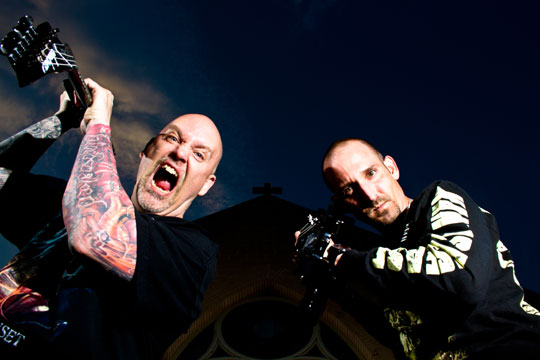
Starting as a one-man band back in 2006, Bloodsoaked released two more albums of fast but explosive death metal and now are planning to unleash their fourth album, Devouring Abomination. Much like the earlier albums, this is ripping Morbid Angel/Vader style material with a tendency to use choppy riffs to accent it.
While many death metal bands have pursued a tendency to cluster riffs and detours onto their music, Bloodsoaked is about driving home a point. Fast riffs pick up a theme, which then starts to be clipped and chopped as it rockets home to percussive conclusions. Riffs tend to be cyclic with variations, making each song easy to appreciate but hiding a few surprises in the wings.
Bloodsoaked is streaming their full albums on their Stereokiller website, but the wait for Devouring Abomination has just begun. The band will be on tour in Europe starting in April, but then will return to unleash their latest platter of eviscerating death metal.
We were fortunate to get an audience with Pete Hasselbrack from Bloodsoaked, who gave the following interview in the midst of planning for the upcoming assault known as Devouring Abomination.
You’ve got an upcoming album called Devouring Abomination. How do you think this album is different from your earlier work, The Death of Hope, Sadistic Deeds, and Brutally Butchered?
I would say the new music is similar as the last albums. I’ve gotten better as a song writer over the years and have a new guitarist (Joseph) that is also giving some new inspiration. Bloodsoaked always has and all ways will be pretty straight forward Death Metal with catchy choruses and the new album will be the same. The new album will only be an EP and it’ll be released along with a Bloodsoaked DVD as well with some live footage, interviews, studio, recording, song writing and more.
How did you produce this album, and how much time did you spend in the studio? Do you think production is important for death metal, especially the brutal death metal style?
The songs for the new album are still being worked on and finished so there is no studio time put into the new album as of yet. I have recorded some demo material, one of the demo songs we just released online called “Devouring.” It’s a rough demo version but thought it was good enough to share. Yes, production in Death Metal is just as important as any other style of music if not more. Trying to get everything in extreme music to sound cohesive can be tough sometimes so a killer mix/master really can help. Production in Death Metal keeps getting better and better all the time.
Bloodsoaked will be going on tour to support Devouring Abomination. What are your thoughts going into this tour?
Yeah, we are going on a ten-day tour of Germany, Netherlands and Poland in less than two weeks. We are very excited to be going back overseas, we were overseas this past November for ten days and we’re hoping to have another successful tour. We have 4 great support bands (SHORT FUSE, PSYCHIATRIC REGURGITATION, BLACK MASS and HATE STORM ANNIHILATION) going with us to make this a 100% USA band tour coming to Europe.
How would you describe your music to others? “Brutal Death Metal” doesn’t seem to describe the range of your music, which is also noticeably different from other brutal death metal bands. What made you decide to take this particular approach to creating death metal?
“Brutal” has some many meanings in Death Metal; I have always described Bloodsoaked as “100% pure Death Metal, nothing more, nothing less.” I grew up on the old school Death Metal when bands had choruses that people could sing along too so I am all about the catchy chorus in Bloodsoaked’s music. I try to write songs and not Death Metal music.
You’ve released a demo version of the song “Devouring.” How different do you think the album version will be? Is there often a big difference between your demo material and the album version?
The music itself is pretty close to the final version but the vocals will be much better on the final version. The vocals were recorded with my home studio equipment and not very well. The final version will be more polished and cleaned up a bit with a proper mix/master.
What do you think has changed in your outlook toward death metal, and how you create death metal, over the years?
Death Metal hasn’t changed to much in the past 20 years; while drummers might have gotten faster, the overall music is still the same as it should be. This is Death Metal and meant to be underground; it was never meant to be popular and I hope it never will be.
Who would you identify as the biggest innovators and founding acts of the brutal death metal style?
All the old school bands: Possessed, Death, Obituary, Carcass, Napalm Death, Cannibal Corpse, Pestilence, Deicide, Morbid Angel, Malevolent Creation, Sepultura and so on.
Some people criticize lyrics about death, violence, war and carnage as being without purpose. What do you hope to communicate with your lyrics? How do you contrast that to what (for example) Carcass and Suffocation communicate?
Bloodsoaked lyrics has always been about killing, gore and anti-religion and always will be. Death Metal is extreme so extreme lyrics should go with it. Having lyrics about love or how beautiful the day is in a Death Metal song just wouldn’t fit; if people don’t like the lyrics go listen to something else.
What are your hopes for the future? In five years, where do you want Bloodsoaked to be, and what do you think your music will sound like?
I’m happy where Bloodsoaked is right now. I have accomplished more things than 99% of the Death Metal bands out there so if it was to all end now I would be ok with it. I’m not sure how much further I can take Bloodsoaked and still have a full time job. Five, ten or fifteen years from now Bloodsoaked’s music will still sound the same and that’s a good thing.
Bloodsoaked – Rotting in Europe 2013 Tour
- April 5 – Görlitz (Ger) – Vierradenmühle
- April 6 – Warsaw (Pl) – Klub Progresja
- April 7 – Poznan (Pl) – Klub u Bazyla
- April 8 – Amsterdam (Nl) – The Cave
- April 9 – Winschoten (Nl) – Boelie’s Pub
- April 10 – Arnhem (Nl) – Willemeen
- April 11 – Hamburg (Ger) – Bambi Galore
- April 12 – Freiberg (Ger) – Train Control
- April 13 – Weißenfels (Ger) – Schlosskeller
- April 14 – Cottbus (Ger) – La Casa
Tags: bloodsoaked, death metal
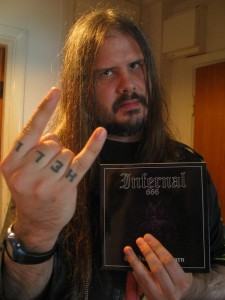 According to Wikipedia and internet sages, David Parland (Necrophobic, Dark Funeral, Infernal) has died at the age of 42 on March 19, 2013.
According to Wikipedia and internet sages, David Parland (Necrophobic, Dark Funeral, Infernal) has died at the age of 42 on March 19, 2013.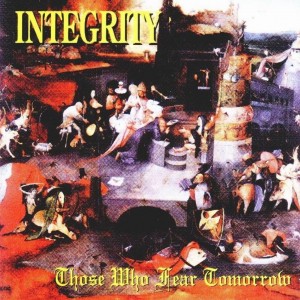 In the early 1980s, punks had a wary attitude toward metal because they saw it as commercializing their music. As I finally get around to hearing Integrity’s Those Who Fear Tomorrow, I see their point, although it’s not an important one.
In the early 1980s, punks had a wary attitude toward metal because they saw it as commercializing their music. As I finally get around to hearing Integrity’s Those Who Fear Tomorrow, I see their point, although it’s not an important one.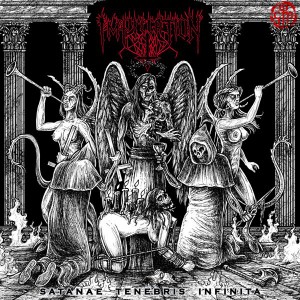 For a brief moment in time, forces of the cosmos united to shape from raw aether a new style of music. This music, called “death metal,” brought together a total alienation from modern life with a desire for the forbidden realms of death and the occult. In this new form, a few sage voices prevailed.
For a brief moment in time, forces of the cosmos united to shape from raw aether a new style of music. This music, called “death metal,” brought together a total alienation from modern life with a desire for the forbidden realms of death and the occult. In this new form, a few sage voices prevailed.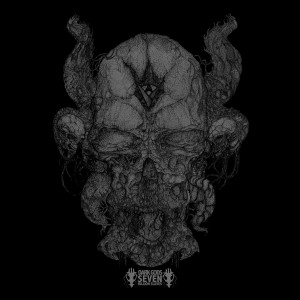
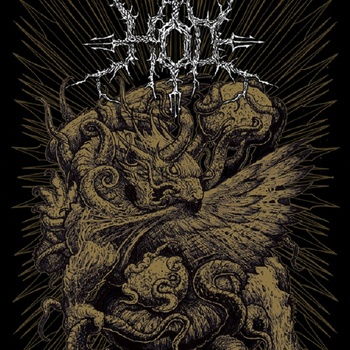 We recently spoke to Hod guitarist Lord Necron about their new demo as well as previous happenings with the band. That interview can be read
We recently spoke to Hod guitarist Lord Necron about their new demo as well as previous happenings with the band. That interview can be read 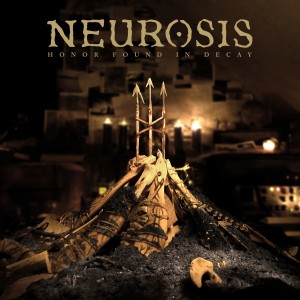 Neurosis got a bad rap among metalheads because most of us got introduced to this innovative band at the peak of their career, when metal journalists and radio were pushing the metalcore trend and wanted us to consider Neurosis part of that movement.
Neurosis got a bad rap among metalheads because most of us got introduced to this innovative band at the peak of their career, when metal journalists and radio were pushing the metalcore trend and wanted us to consider Neurosis part of that movement.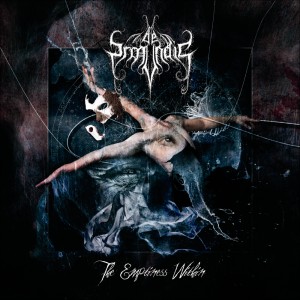 Every age has its conventions that set a target for those who aspire to success. When they achieve a fulfillment of those conventions, the aspirants have entered the elite and expect great reward to follow.
Every age has its conventions that set a target for those who aspire to success. When they achieve a fulfillment of those conventions, the aspirants have entered the elite and expect great reward to follow.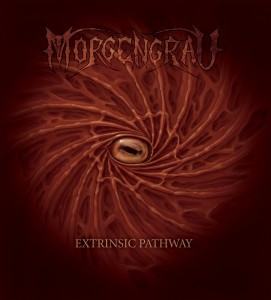 Morgengrau unleash an album described as classic death metal, while in actuality it sounds more like 1980s metal merged with progressive death metal from a decade later. Despite being a relatively new band, Morgengrau includes several experienced players alongside enthusiastic new blood, and the result shows on this thoroughly professional album.
Morgengrau unleash an album described as classic death metal, while in actuality it sounds more like 1980s metal merged with progressive death metal from a decade later. Despite being a relatively new band, Morgengrau includes several experienced players alongside enthusiastic new blood, and the result shows on this thoroughly professional album.
